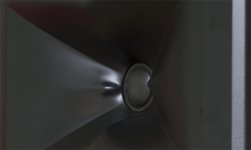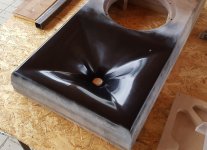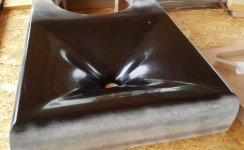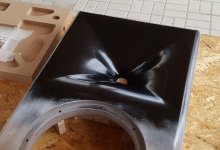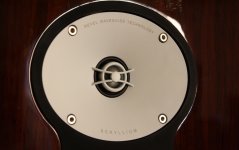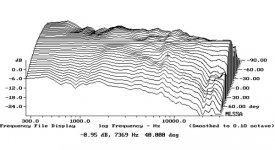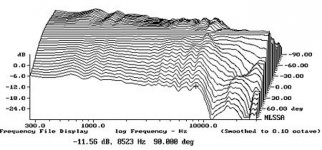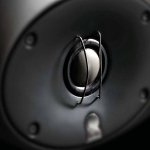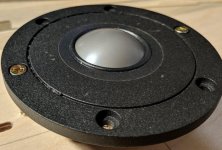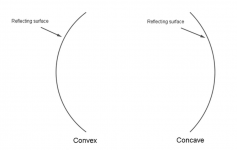The large dome of the T-34A appears to be (almost) hemispherical and therefore may not be the ideal candidate for waveguide loading.
Hificompass has a nice looking measurement for the T25 B on a waveguide he made. The dome is smaller but the shape looks quite similar.
.png)
Looks awesomeToday I received prototypes of Tritonia baffles.
Hificompass has a nice looking measurement for the T25 B on a waveguide he made. The dome is smaller but the shape looks quite similar.
Yes, the T25B seems to work (better).
Augerpro has tested it with several waveguides, with and without phase shield.

Last edited:
Today I received prototypes of Tritonia baffles. Now, I don't need to measure or listen to anything to recognize this is something extraordinary
That baffle looks very solid indeed.
Will you be testing this one in combination with the HF1440?
Last edited:
The scales are different which can make it hard to compare but what surprised me about the hificompass one was that it was only 10dB down at 60 degrees off axis at 20K which I think is a good result, Augerpro's is good too but that has fallen to 15dB at the same point.Yes, the T25B seems to work (better).
Augerpro has tested it with several waveguides, with and without phase shield
The hificompass one seems to be a more similar directivity that mabat has been aiming for in his waveguides. There seems to a trend that with dome tweeters if the waveguide is deeper the result is better if the tweeter is smaller. I suppose the same is true of compression drivers if they aren't needed to go as low in frequency.
Augerpro's still working on these, I believe.
Dome tweeters interact differently with waveguides compared to compression drivers.
Smaller dome tweeters (and ring radiators) work better, because of their inherent ability to move pistonically up to higher frequencies - without flexing, compared to their bigger brothers.
A conventional dome tweeter is 'edge-driven', whereas the ring radiator is basically center-driven. Here's some background info on (non-horn loaded) tweeters:
"To a fixed point on axis, the distance from various points on the diaphragm will vary because of the curvature of the dome. The result is an aperture effect that causes an HF roll-off dependant on the height of the dome. In all real dome tweeters, the height of the dome is so small compared to the wavelength of the highest audible frequency that the HF roll off is essentially out of the audio band.
Considering off-axis response, the aperture effect increases as the spread of distances from points on the diaphragm gets broader, dependent on the diameter of the dome. The off axis response is not affected by the height of the dome, only by the diameter.
Basically, for pistonic motion, the dome shape has absolutely no effect whatsoever on the sound radiation on-axis or off-axis. The diaphragm could be a convex dome, a concave dome or absolutely flat and it wouldn’t make any difference. In other words the dome shape is having no effect whatsoever and the directivity is not improved.
At high frequencies it is not possible for a diaphragm driven by a coil to move pistonically. The finite propagation speed of vibrations through the diaphragm prevents pistonic motion. In the case of a cone-type HF unit, the vibrations from the coil spread outwards across the diaphragm and are absorbed by the roll surround which acts as a terminator.
In a dome driver, the vibrations begin at the outside and travel inwards as shown in the attached figure. There is nothing to stop them traveling all the way across the dome, where they will not be terminated, but will instead find a mechanical impedance mismatch where the coil and diaphragm are joined, which will reflect them back again. Clearly having vibrations bouncing back and forth across the diaphragm is a recipe for standing waves.
The solution to the standing wave problem was to make the diaphragm somewhat compliant, the so-called soft dome, by impregnating it with a dope that remained flexible. The flexibility of the diaphragm introduced a source of damping and the standing waves were tamed. Unfortunately, the standing wave problem was solved by the introduction of another problem, to which there is no solution.
If one imagines a soft dome excited at the perimeter, then the vibrations travel inwards and are absorbed by the lossy material mentioned above. The attached figure (b) shows that the amplitude of dome motion is greatest at the perimeter and reduces towards the centre. This mechanism is frequency dependent. At high frequency the centre of the dome might not move at all. In the on-axis condition, the result is a mild loss of high frequency output, which is tolerable.
An ideal tweeter would have a radiating area that became smaller as frequency rose, such that the aperture effect applied to off-axis radiation would be windowed and thereby minimised. In the dome tweeter, this does not happen. Instead as frequency rises the radiation takes place more from the perimeter than from the centre.
Unlike a cone-type tweeter, in which the effective diaphragm gets smaller with frequency as the outer parts of the cone decouple, in the case of the dome tweeter it is the inside of the diaphragm that decouples and it becomes an annular radiator. The aperture to an off axis destination is not windowed. The inevitable result is serious beaming with a fall-off of output off axis. Thus the dome tweeter has exactly the opposite characteristic to the one that is required, a characteristic that is fundamental and about which absolutely nothing can be done (except by using Beryllium (Carbyne?) domes).
Another common feature of dome tweeters is that the magnetic circuit behind the diaphragm is solid metal. Sound radiated backwards from the diaphragm bounces off the metal and returns. The soft dome causes insufficient loss to the returning sound which passes through and adds to the direct sound, after a delay due to the extra path length. Essentially the reflection from the pole has created an acoustic comb filter.
In the frequency domain the comb filter makes the frequency response periodic. In the time domain the location of a transient becomes uncertain. The characteristic footprint of the soft dome tweeter will always be there irrespective of manufacturer. The sound is best described as harsh or brittle, as if the waveform had ground glass in it. Frequently the soft dome is found in conjunction with a conventional cone-type woofer in a two-way speaker. The disparity between the characteristics of the two drivers means that the crossover will never succeed and the two parts of the spectrum seem to be quite dissociated. One famous studio monitoring speaker, which was quite good in other respects, especially as the woofer was not ported, was frequently seen with a piece of tissue paper mounted in front of the dome tweeter in order to filter out some of the harshness.
As mentioned above, it makes no sonic difference if the dome is convex or concave, whereas the concave dome is useful in compact devices. A number of concave dome tweeter designs have appeared (Focal a.o.), with the diaphragm made from aluminium alloy, and some have the centre pole shaped to prevent reflection of the back wave. These devices have eliminated the brittle sound of the soft dome, but the directivity problems remain."
Dome tweeters interact differently with waveguides compared to compression drivers.
Smaller dome tweeters (and ring radiators) work better, because of their inherent ability to move pistonically up to higher frequencies - without flexing, compared to their bigger brothers.
A conventional dome tweeter is 'edge-driven', whereas the ring radiator is basically center-driven. Here's some background info on (non-horn loaded) tweeters:
"To a fixed point on axis, the distance from various points on the diaphragm will vary because of the curvature of the dome. The result is an aperture effect that causes an HF roll-off dependant on the height of the dome. In all real dome tweeters, the height of the dome is so small compared to the wavelength of the highest audible frequency that the HF roll off is essentially out of the audio band.
Considering off-axis response, the aperture effect increases as the spread of distances from points on the diaphragm gets broader, dependent on the diameter of the dome. The off axis response is not affected by the height of the dome, only by the diameter.
Basically, for pistonic motion, the dome shape has absolutely no effect whatsoever on the sound radiation on-axis or off-axis. The diaphragm could be a convex dome, a concave dome or absolutely flat and it wouldn’t make any difference. In other words the dome shape is having no effect whatsoever and the directivity is not improved.
At high frequencies it is not possible for a diaphragm driven by a coil to move pistonically. The finite propagation speed of vibrations through the diaphragm prevents pistonic motion. In the case of a cone-type HF unit, the vibrations from the coil spread outwards across the diaphragm and are absorbed by the roll surround which acts as a terminator.
In a dome driver, the vibrations begin at the outside and travel inwards as shown in the attached figure. There is nothing to stop them traveling all the way across the dome, where they will not be terminated, but will instead find a mechanical impedance mismatch where the coil and diaphragm are joined, which will reflect them back again. Clearly having vibrations bouncing back and forth across the diaphragm is a recipe for standing waves.
The solution to the standing wave problem was to make the diaphragm somewhat compliant, the so-called soft dome, by impregnating it with a dope that remained flexible. The flexibility of the diaphragm introduced a source of damping and the standing waves were tamed. Unfortunately, the standing wave problem was solved by the introduction of another problem, to which there is no solution.
If one imagines a soft dome excited at the perimeter, then the vibrations travel inwards and are absorbed by the lossy material mentioned above. The attached figure (b) shows that the amplitude of dome motion is greatest at the perimeter and reduces towards the centre. This mechanism is frequency dependent. At high frequency the centre of the dome might not move at all. In the on-axis condition, the result is a mild loss of high frequency output, which is tolerable.
An ideal tweeter would have a radiating area that became smaller as frequency rose, such that the aperture effect applied to off-axis radiation would be windowed and thereby minimised. In the dome tweeter, this does not happen. Instead as frequency rises the radiation takes place more from the perimeter than from the centre.
Unlike a cone-type tweeter, in which the effective diaphragm gets smaller with frequency as the outer parts of the cone decouple, in the case of the dome tweeter it is the inside of the diaphragm that decouples and it becomes an annular radiator. The aperture to an off axis destination is not windowed. The inevitable result is serious beaming with a fall-off of output off axis. Thus the dome tweeter has exactly the opposite characteristic to the one that is required, a characteristic that is fundamental and about which absolutely nothing can be done (except by using Beryllium (Carbyne?) domes).
Another common feature of dome tweeters is that the magnetic circuit behind the diaphragm is solid metal. Sound radiated backwards from the diaphragm bounces off the metal and returns. The soft dome causes insufficient loss to the returning sound which passes through and adds to the direct sound, after a delay due to the extra path length. Essentially the reflection from the pole has created an acoustic comb filter.
In the frequency domain the comb filter makes the frequency response periodic. In the time domain the location of a transient becomes uncertain. The characteristic footprint of the soft dome tweeter will always be there irrespective of manufacturer. The sound is best described as harsh or brittle, as if the waveform had ground glass in it. Frequently the soft dome is found in conjunction with a conventional cone-type woofer in a two-way speaker. The disparity between the characteristics of the two drivers means that the crossover will never succeed and the two parts of the spectrum seem to be quite dissociated. One famous studio monitoring speaker, which was quite good in other respects, especially as the woofer was not ported, was frequently seen with a piece of tissue paper mounted in front of the dome tweeter in order to filter out some of the harshness.
As mentioned above, it makes no sonic difference if the dome is convex or concave, whereas the concave dome is useful in compact devices. A number of concave dome tweeter designs have appeared (Focal a.o.), with the diaphragm made from aluminium alloy, and some have the centre pole shaped to prevent reflection of the back wave. These devices have eliminated the brittle sound of the soft dome, but the directivity problems remain."
Attachments
Last edited:
So, how does this work out in real life?
I've attached the (inconsistent) in-room measurements by John Atkinson of the Revel Performa F228Be and the Revel Ultima Studio2, that also features a Beryllium dome tweeter + a shallow waveguide (albeit without phase shield).
Notes:
Lateral response family at 50", normalized to response on tweeter axis, from back to front: differences in response 90–5° off axis, reference response, differences in response 5–90° off axis.
I've attached the (inconsistent) in-room measurements by John Atkinson of the Revel Performa F228Be and the Revel Ultima Studio2, that also features a Beryllium dome tweeter + a shallow waveguide (albeit without phase shield).
Notes:
Lateral response family at 50", normalized to response on tweeter axis, from back to front: differences in response 90–5° off axis, reference response, differences in response 5–90° off axis.
Attachments
Last edited:
I've chosen Bliesma tweeters mainly because they move pistonically through the audio band, so the numerical prediction based on this assumption should be in a good match, and it is indeed.
One important thing is missing from the previous storytelling - a mentioning of the presence of a surround inside the waveguide. This can and have a big effect. As I showed several times in this thread, an axially vibrating dome (a convex one) works quite well in a conical waveguide, but that was without the surround. Now I have the possibility to include the surround in the simulations and that's the moment things start to go, well, not so well. And I don't agree that a shape of the diaphragm itself doesn't have any effect, it obviously does have some effect.
If you wait for 4.6 you will be able to try all of this for yourself.
One important thing is missing from the previous storytelling - a mentioning of the presence of a surround inside the waveguide. This can and have a big effect. As I showed several times in this thread, an axially vibrating dome (a convex one) works quite well in a conical waveguide, but that was without the surround. Now I have the possibility to include the surround in the simulations and that's the moment things start to go, well, not so well. And I don't agree that a shape of the diaphragm itself doesn't have any effect, it obviously does have some effect.
If you wait for 4.6 you will be able to try all of this for yourself.
Last edited:
That's the plan.Will you be testing this one in combination with the HF1440?
Whether a tweeter works with a waveguide largely depends on the size, shape and the material of the dome and the surround.
The issue is that any surround adds a complex acoustic velocity profile across the radiating surface. A pistonic spherical cap of the diaphragm itself moves less and less air (per unit area) as you go from the apex to the voice coil. Then, if the surround is flat, it suddenly moves more near the voice coil and progressively less towards the outer edge. I believe this is mainly what complicates things. With a half-roll surround it is a bit different again.
Last edited:
A funny thing is that based on this photo I would have never thought that the surround is actually concave.
Maybe it's not that simple. I'm really looking forward to see you guys playing with the different source shapes in the simulator (including ring radiators, etc.). I think much can be revealed, I just don't have the time to explore all of this myself.
Maybe it's not that simple. I'm really looking forward to see you guys playing with the different source shapes in the simulator (including ring radiators, etc.). I think much can be revealed, I just don't have the time to explore all of this myself.
Last edited:
- Home
- Loudspeakers
- Multi-Way
- Acoustic Horn Design – The Easy Way (Ath4)
